Impact of Multiple HVAC Systems on Indoor Air VOC and Radon Concentrations from Vapor Intrusion During Seasonal Usage
Abstract
1. Introduction
Background
2. Materials and Methods
2.1. Regional Geology and Climate
2.2. Building and HVAC Characteristics
2.3. Weather
2.4. Sampling and Analysis
3. Results and Discussion
3.1. Church—PCE
3.2. Residential-Style Office Building—PCE
4. Conclusions
Supplementary Materials
Author Contributions
Funding
Institutional Review Board Statement
Informed Consent Statement
Data Availability Statement
Acknowledgments
Conflicts of Interest
References
- Office of Solid Waste and Emergency Response. OSWER Technical Guide for Assessing and Mitigating the Vapor Intrusion Pathway from Subsurface Vapor Sources to Indoor Air; Report OSWER Publication 9200.2-154; U.S. Environmental Protection Agency: Washington, DC, USA, 2015. Available online: https://www.epa.gov/sites/default/files/2015-09/documents/oswer-vapor-intrusion-technical-guide-final.pdf (accessed on 5 March 2025).
- Luo, H.; Dahlen, P.; Johnson, P.C.; Peargin, T.; Creamer, T. Spatial variability of soil-gas concentrations near and beneath and building overlying shallow petroleum hydrocarbon-impacted soils. Groundw. Monit. Remediat. 2009, 29, 81–91. [Google Scholar] [CrossRef]
- Schuver, H.J.; Mosley, R.B. Vapor Intrusion: Lessons from Radon Studies. In Proceedings of the Air and Waste Management Association Vapor Intrusion Conference, San Diego, CA, USA, 27–30 January 2009. [Google Scholar]
- Provoost, J.; Tillman, F.; Weaver, J.; Reijnders, L.; Bronders, J.; Van Keer, I.; Swartjes, F. Vapour intrusion into buildings: A literature review. In Advances in Environmental Research; Nova Science Publshers, Inc.: Hauppauge, NY, USA, 2010; Volume 5, ISBN 978-1-61668-744-1. Available online: https://www.academia.edu/18759163/Vapour_intrusion_into_buildings_A_literature_review (accessed on 5 March 2025).
- Office of Solid Waste and Emergency Response. Conceptual Model Scenarios for the Vapor Intrusion Pathway; Report EPA 530-R-10-003; U.S. Environmental Protection Agency: Washington, DC, USA, 2012. Available online: https://www.epa.gov/sites/default/files/2015-09/documents/vi-cms-v11final-2-24-2012.pdf (accessed on 5 March 2025).
- Ma, J.; McHugh, T.E.; Beckley, L.; Lahvis, M.A.; DeVaull, G.; Jiang, L. Vapor intrusion investigations and decision-making: A critical review. Environ. Sci. Technol. 2020, 54, 7050–7069. [Google Scholar] [CrossRef]
- Folkes, D.; Wertz, W.; Kurtz, J.; Kuehster, T. Observed spatial and temporal distributions of CVOCs at Colorado and New York vapor intrusion sites. Groundw. Monit. Remediat. 2009, 29, 70–80. [Google Scholar] [CrossRef]
- U.S. Environmental Protection Agency. Fluctuation of Indoor Radon and VOC Concentrations Due to Seasonal Variability; Report EPA/600/R-12/673; Environmental Protection Agency: Washington, DC, USA, 2012. Available online: https://cfpub.epa.gov/si/si_public_record_report.cfm?Lab=NERL&dirEntryId=247212 (accessed on 5 March 2025).
- Holton, C.; Luo, H.; Dahlen, P.; Gorder, K.; Dettenmaier, E.; Johnson, P.C. Temporal variability in indoor air concentrations under natural conditions in a house overlying a dilute chlorinated solvent groundwater plume. Environ. Sci. Technol. 2013, 47, 13347–13354. [Google Scholar] [CrossRef] [PubMed]
- Brenner, D. Results of a long-term study of vapor intrusion at four large buildings at the NASA Ames Research Center. J. Air Waste Manag. Assoc. 2010, 60, 747–758. [Google Scholar] [CrossRef]
- Hosangadi, V.; Shaver, B.; Hartman, B.; Pound, M.; Kram, M.L.; Frescura, C. High-frequency continuous monitoring to track vapor intrusion resulting from naturally occurring pressure dynamics. Remediat. J. 2017, 27, 9–25. [Google Scholar] [CrossRef]
- Lutes, C.; Buckley, G.; Boyd, V.; Levy, L.; Caldwell, D.; Hallberg, K.; Lund, L.; Truesdale, R.; Lewis, T.; Walker, T.; et al. “Eighteen Months of High Resolution Indoor and Subslab Temporal Observations from an Industrial Building” Presented as part of U.S. EPA “State of VI Science” Workshop Reducing Vapor Intrusion Uncertainties by More Frequent Simple Meas-urements and Community Involvement. In Proceedings of the AEHS 30th Annual International (West Coast) Conference on Soil, Water, Energy, and Air, San Diego, CA, USA, 22–25 March 2021; Available online: https://iavi.rti.org/assets/docs/04_High%20Res_Indoor_Subslab_2021_AEHS.pdf (accessed on 16 January 2025).
- Levy, L.C.; Lutes, C.C.; Lund, L.G. State-Specific Considerations for Investigative Strategies in Vapor Intrusion Guidance Documents: Overview and Comparison Poster. In Proceedings of the 35th Annual International Conference on Soils, Sediments, Water and Energy, Amherst, MA, USA, 21–24 October 2019. [Google Scholar]
- Schuver, H.J.; Lutes, C.; Kurtz, J.; Holton, C.; Truesdale, R.S. Chlorinated vapor intrusion indicators, tracers, and surrogates (ITS): Supplemental measurements for minimizing the number of chemical indoor air samples—Part 1: Vapor intrusion driving forces and related environmental factors. Remediat. J. 2018, 28, 7–31. [Google Scholar] [CrossRef]
- MacGregor, I.; Prier, M.; Rhoda, D.; Dindal, A.; McKernan, J. Environmental Technology Verification Report. Verification of Building Pressure Control as Conducted by GSI Environmental, Inc. For the Assessment of Vapor Intrusion. December 2011. Available online: https://nepis.epa.gov/Exe/ZyPDF.cgi?Dockey=P100ELXG.txt (accessed on 5 March 2025).
- Mosley, R.B.; Greenwell, D.; Lee, A.; Baylor, K.; Plate, M.; Lutes, C. Use of Integrated Indoor Radon and Volatile Organic Compounds (VOCs) to Distinguish Soil Sources from Above-Ground Sources. In Proceedings of the AWMA Symposium on Air Quality Measurement and Technology, Chapel Hill, NC, USA, 6 November 2008. [Google Scholar] [CrossRef]
- GSI Environmental Inc. Final Report: Detailed Field Investigation of Vapor Intrusion Processes ESTCP Project ER-0423. September 2008. Available online: https://clu-in.org/download/contaminantfocus/vi/detailed%20field%20investigation%20of%20vi.pdf (accessed on 16 January 2025).
- Lutes, C.C.; Uppencamp, R.; Abreu, L.; Singer, C.; Mosley, R.; Greenwell, D. Radon Tracer as a Multipurpose Tool to Enhance Vapor Intrusion Assessment and Mitigation. In Proceedings of the AWMA Specialty Conference: Vapor Intrusion 2010, Chicago, IL, USA, 28–30 September 2010; Available online: https://oaspub.epa.gov/eims/eimscomm.getfile?p_download_id=498943 (accessed on 5 March 2025).
- Schuver, H.; Steck, D.; Schumacher, B.; Lutes, C.; Holton, C. Technical Basis for the use of Indoor Radon Measurements for Chemical Vapor Intrusion Concerns. In Proceedings of the AARST International Radon Symposium, San Diego, CA, USA, 18–23 September 2016; Available online: https://aarst.org/proceedings/2016/Schuver_Technical_Basis_For_The_Use_Of_Indoor_Radon_Measurements_For_Chemical_Vapor_Intrusion_Concerns.pdf (accessed on 5 March 2025).
- Schuver, H.J.; Steck, D.J. Cost-Effective Rapid and Long-Term Screening of Chemical Vapor Intrusion (CVI) Potential: Across Both Space and Time. Remediat. J. 2015, 25, 27–53. [Google Scholar] [CrossRef]
- Lutes, C.; Holton, C.; Schumacher, B.; Zimmerman, J.; Kondash, A.; Truesdale, R. Observation of conditions preceding peak indoor air volatile organic compound concentrations in vapor intrusion studies. Groundw. Monit. Remediat. 2021, 41, 99–111. [Google Scholar] [CrossRef]
- Lutes, C.; Levy, L.; Kondash, A.J.; Holton, C. “Summary of Relevant Vapor Intrusion (VI) Indicator and Tracer (I&T) Research: Recently Completed, On-going & Planned” oral presentation at U.S. EPA “State of VI Science” Workshop How Vapor Intrusion Data Measured by Communities and Supported by Regulators Can Create “Soil Gas Safe Communities”. In Proceedings of the 31st Annual International Conference on Soil, Water, Energy, and Air, San Diego, CA, USA, 14–17 March 2022; Available online: https://iavi.rti.org/assets/docs/05_Lutes_Summary_of_VI_Research.pdf (accessed on 5 March 2025).
- Lotrecchiano, N.; Montano, L.; Bonapace, I.M.; Giancarlo, T.; Trucillo, P.; Sofia, D. Comparison Process of Blood Heavy Metals Absorption Linked to Measured Air Quality Data in Areas with High and Low Environmental Impact. Processes 2022, 10, 1409. [Google Scholar] [CrossRef]
- Johnson, P.C.; Holton, C.; Guo, Y.; Dahlen, P.; Luo, H.; Gorder, K.; Dettenmaier, E.; Hinchee, R. Integrated Field-Scale, Lab-Scale, and Modeling Studies for Improving Our Ability to Assess the Groundwater to Indoor Air Pathway at Chlorinated Solvent-Impacted Groundwater Sites; Report ER-1686; Strategic Environmental Research and Development Program: Washington, DC, USA, 2016; Available online: https://clu-in.org/download/issues/vi/VI-ER-1686-FR.pdf (accessed on 5 March 2025).
- Barnes, D.L.; McRae, M.F. The predictable influence of soil temperature and barometric pressure changes on vapor intrusion. Atmos. Environ. 2017, 150, 15–23. [Google Scholar] [CrossRef]
- Lund, L.; Lutes, C.; Levey, L.; Hallberg, K.; Caldwell, D.; Lewis, T. Vapor Intrusion (VI) Indicators, Tracers, and Temporal Variability of cVOCs in Industrial Buildings DoD Virginia Site A—Climate Zone 4. In Proceedings of the AEHS East Coast Conference, Amhurst, MA, USA, 21–24 October 2019. [Google Scholar]
- Venable, P.; Chaudhry, T.; Caldwell, D.; Rivera-Duarte, I.; Lutes, C.; Lund, L.; Hallberg, K. A quantitative Decision Framework for Assessing Navy Vapor Intrusion Sites; Report TR-NAVFAC-EXWC-EV-1603; Engineering and Expeditionary Warfare Center: Washington, DC, USA, 2015; Available online: https://clu-in.org/download/issues/vi/TR-NAVFAC-EXWC-EV-1603.pdf (accessed on 5 March 2025).
- Brewer, R.; Nagashima, J.; Rigby, M.; Schmidt, M.; O’Neill, H. Estimation of generic subslab attenuation factors for vapor intrusion investigations. Groundw. Monit. Remediat. 2014, 34, 79–92. [Google Scholar] [CrossRef]
- Clausen, J.; Moore, D.; Cain, L.; Malinowkia, K. VI Preferential Pathways: Rule or Exception. In Proceedings of the AEHS West Coast Conference, San Diego, CA, USA, 18–21 March 2019. [Google Scholar]
- Office of Research and Development. Simple, Efficient, and Rapid Methods to Determine the Potential for Vapor Intrusion into the Home: Temporal Trends, Vapor Intrusion Forecasting, Sampling Strategies, and Contaminant Migration Routes; Report EPA/600/R-15/070; U.S. Environmental Protection Agency: Washington, DC, USA, 2015. Available online: https://cfpub.epa.gov/si/si_public_record_report.cfm?Lab=NERL&dirEntryId=309644 (accessed on 5 March 2025).
- Song, S.; Schnorr, B.A.; Ramacciotti, F.C. Quantifying the influence of stack and wind effects on vapor intrusion. Hum. Ecol. Risk Assess. Int. J. 2014, 20, 1345–1358. [Google Scholar] [CrossRef]
- Reichman, R.; Shirazi, E.; Colliver, D.G.; Pennell, K.G. US residential building air exchange rates: New perspectives to improve decision making at vapor intrusion sites. Environ. Sci. Process. Impacts 2017, 19, 87–100. [Google Scholar] [CrossRef]
- Song, S.; Schnorr, B.A.; Ramacciotti, F.C. Accounting for climate variability in vapor intrusion assessments. Hum. Ecol. Risk Assess. Int. J. 2018, 24, 1838–1851. [Google Scholar]
- Shirazi, E.; Ojha, S.; Pennell, K.G. Building science approaches for vapor intrusion studies. Rev. Environ. Health 2019, 34, 245–250. [Google Scholar] [CrossRef]
- Dames and Moore. Release Investigation Interim Report; State of Alaska Department of Environmental Conservation: Fairbanks, AK, USA, 1993. [Google Scholar]
- Oasis Environmental. Fiscal Year 2011 Vapor Intrusion and Groundwater Monitoring Report; Gaffney Road East Area-Wide Investigation: Fairbanks, AK, USA, 2011. Available online: https://dec.alaska.gov/Applications/SPAR/PublicMVC/CSP/Download?documentID=58363&fileName=2919_2011%20West%20VI%20and%20GW%20Report%20Final.pdf (accessed on 5 March 2025).
- Ecology and Environment, Inc. Site Inspection, Coin King Laundromat; Gaffney Road East Area-Wide Investigation: Fairbanks, Alaska, 2014. Available online: https://dec.alaska.gov/Applications/SPAR/PublicMVC/CSP/SiteReport/25573 (accessed on 5 March 2025).
- Ahtna Environmental. State Fiscal Year 2017 Groundwater Monitoring, Soil Gas Monitoring, Well Inventory, Remedial System Evaluation, and Mitigation System Operations and Maintenance Report; State of Alaska Department of Environmental Conservation: Fairbanks, AK, USA, 2018. [Google Scholar]
- Wendler, G.; Shulski, M. A century of climate change for Fairbanks, Alaska. ARCTIC 2009, 62, 295–300. Available online: https://digitalcommons.unl.edu/natrespapers/563/ (accessed on 5 March 2025).
- Alaska Climate Research Center. Temperature Extremes. Available online: https://akclimate.org/data/temperature-extremes/ (accessed on 7 January 2025).
- Western Regional Climate Center. Period of Record Monthly Climate Summary: Fairbanks International Airport, Alaska. 2016. Available online: https://wrcc.dri.edu/cgi-bin/cliMAIN.pl?ak2968 (accessed on 5 March 2025).
- Rozell, N. Temperature Inversions Go to Extremes. University of Alaska, Online Science Forum. 2007. Available online: https://www.gi.alaska.edu/alaska-science-forum/temperature-inversions-go-extremes (accessed on 5 March 2025).
- Ward, T.J. The Fairbanks, Alaska PM2.5 Source Apportionment Research Study, Missoula Center for Environmental Health Sciences. 2013. Available online: https://dec.alaska.gov/media/7083/fairbanks-cmb-report-univ-mt-final-122313.pdf (accessed on 5 March 2025).
- Péwé, T.L.; Well, B.J.; Forbes, R.B.; Weber, F.R. Geologic Map of the Fairbanks D-2 SW Quadrangle, Alaska. 1976. Available online: https://dggs.alaska.gov/pubs/id/12953 (accessed on 5 March 2025).
- U.S. Environmental Protection Agency. State Maps of Radon Zones. Available online: https://www.epa.gov/radon/epa-maps-radon-zones-and-supporting-documents-state (accessed on 7 January 2025).
- Alaska Radon Web Map. Available online: https://gis.data.alaska.gov/maps/alaska-radon-web-map/about (accessed on 7 January 2025).
- Glass, R.L.; Lilly, M.R.; Meyer, D.F. Ground-Water Levels in an Alluvial Plain Between the Tanana and Chena Rivers Near Fairbanks, Alaska, 1986–1993, Report 96-4060. 1996. Available online: https://pubs.usgs.gov/publication/wri964060 (accessed on 5 March 2025).
- U.S. Environmental Protection Agency. Compendium Method TO-17, Determination of Volatile Organic Compounds in Ambient Air Using Active Sampling onto Sorbent Tubes, Washington, DC, 1999. USEPA Method TO-17. Available online: https://www.epa.gov/sites/default/files/2019-11/documents/to-17r.pdf (accessed on 5 March 2025).
- U.S. Environmental Protection Agency. Compendium Method TO-14A, Determination of Volatile Organic Compounds (VOCs) in Ambient Air Using Specially Pre-pared Canisters with Subsequent Analysis by Gas Chromatography, Washington, DC, 1999. USEPA Method TO-14A. Available online: https://www.epa.gov/sites/default/files/2019-11/documents/to-14ar.pdf (accessed on 5 March 2025).
- Carmona, M.A.; Kearfott, K.J. Intercomparison of commercially available active radon measurement devices in a discovered radon chamber. Health Phys. 2019, 116, 852–861. [Google Scholar] [CrossRef]
- U.S. Environmental Protection Agency. Indoor Radon and Radon Decay Product Measurement, Device Protocols, Report EPA 402-R-92-004. Washington, DC, USA. 1992. Available online: https://www.floridahealth.gov/environmental-health/radon/_documents/EPA-Protocols-Devices-004.pdf (accessed on 5 March 2025).
- Michigan Department of Environment, Great Lakes, and Energy (EGLE). Guidance document for the Vapor Intrusion Pathway (VIAP). 2013. Available online: https://www.michigan.gov/egle/about/organization/remediation-and-redevelopment/vapor-intrusion/guidance (accessed on 5 March 2025).
- Ohio Environmental Protection Agency. Sample Collection and Evaluation of Vapor Intrusion to Indoor Air: For Remedial Response, Resource Conservation and Recovery Act and Voluntary Action Programs. Available online: https://epa.ohio.gov/static/Portals/30/vap/docs/VI+guidance+Final+3-6-2020.pdf (accessed on 5 March 2025).
- Vapor Pin Enterprises. Standard Operating Procedure Installation and Extraction of the Vapor Pin Sampling Device. Available online: https://vaporpin.com/wp-content/uploads/01-Standard-Operating-Procedure-VP.pdf (accessed on 5 March 2025).
- Zimmerman, J.H.; Williams, A.; Schumacher, B.; Lutes, C.; Levy, L.; Buckley, G.; Boyd, V.; Holton, C.; McAlary, T.; Truesdale, R. The representativeness of subslab soil gas collection as effected by probe construction and sampling methods. Groundw. Monit. Remediat. 2024, 44, 106–121. [Google Scholar] [CrossRef]
- Bekele, D.N.; Naidu, R.; Chadalavada, S. Influence of spatial and temporal variability of subsurface soil moisture and temperature on vapour intrusion. Atmos. Environ. 2014, 88, 14–22. [Google Scholar] [CrossRef]
- De Biase, C.; Loechel, S.; Putzmann, T.; Bittens, M.; Weiss, H.; Daus, B. Volatile organic compounds effective diffusion coefficients and fluxes estimation through two types of construction material. Indoor Air 2014, 24, 272–282. [Google Scholar] [CrossRef]
- Xie, S.; Suuberg, E. Adsorption of trichloroethylene on common indoor materials studied using a combined inverse gas chromatography and frequency response technique. J. Chromatogr. A 2022, 1669, 462926. [Google Scholar] [CrossRef]
- Oasis Environmental. Additional Source Characterization and Long Term Monitoring; Gaffney Road Area: Fairbanks, AK, USA, 2009. Available online: https://dec.alaska.gov/Applications/SPAR/PublicMVC/CSP/Download?documentID=58372&fileName=25573_2009_%20Final%20Report%20Addtl%20Characterization%20and%20LTM.pdf (accessed on 5 March 2025).
- Nortech. Phase I Environmental Site Assessment Airport Way/Cushman Street Intersection Fairbanks, Alaska. 2017. Available online: https://dot.alaska.gov/nreg/airport-cushman/files/environmental-site-assessment.pdf (accessed on 5 March 2025).
- Grosse, D.; McKernan, J.; Bessler, S. Challenges in Bulk Soil Sampling and Analysis for Vapor Intrusion Screening of Soil; EPA/600/R-14/277; U.S. Environmental Protection Agency: Washington, DC, USA, 2014. Available online: https://cfpub.epa.gov/si/si_public_record_report.cfm?Lab=NRMRL&dirEntryId=310903 (accessed on 5 March 2025).
- Ecology and Environment, Inc. Site inspection: Coin King Laundromat; Technical Direction Document Number: 13-8-0036; United States Environmental Protection Agency: Fairbanks, AK, USA, 2014. [Google Scholar]
- Oasis Environmental. Additional Site Characterization and Long-Term Monitoring Gaffney Road Area; Oasis Environmental: Fairbanks, AK, USA, 2009. Available online: https://dec.alaska.gov/Applications/SPAR/PublicMVC/CSP/Download?documentID=58371&fileName=2919_2009_%20Final%20Report%20Addtl%20Characterization%20and%20LTM.pdf (accessed on 5 March 2025).
- ERM Alaska. State Fiscal Year 2013, Operations and Maintenance of Remediation System and Additional Characterization Report; Gaffney Road West: Fairbanks, AK, USA, 2013. Available online: https://dec.alaska.gov/applications/spar/publicmvc/csp/sitereport/2919 (accessed on 5 March 2025).
- Ecology %amp; Environment. Gaffney Road Area-Wide Phase II Groundwater Investigation, Fairbanks, Alaska; Final Report; ADEC: Anchorage, AK, USA, 1999. [Google Scholar]
- Howe, J.W. The Houses We Live in: An Identification Guide to the History and Style of American Domestic Architecture; Thunder Bay Press: San Diego, CA, USA, 2002. [Google Scholar]
- Fairbanks North Star Borough. Property Tax Database. Available online: https://propertysearch.fnsb.gov/ (accessed on 7 April 2023).
- Weller, A.; (Ahtna Engineering Services, Fairbanks, AK, USA); Lutes, C.; (Jacobs Engineering, Cary, NC, USA). Personal Communication, 2020.

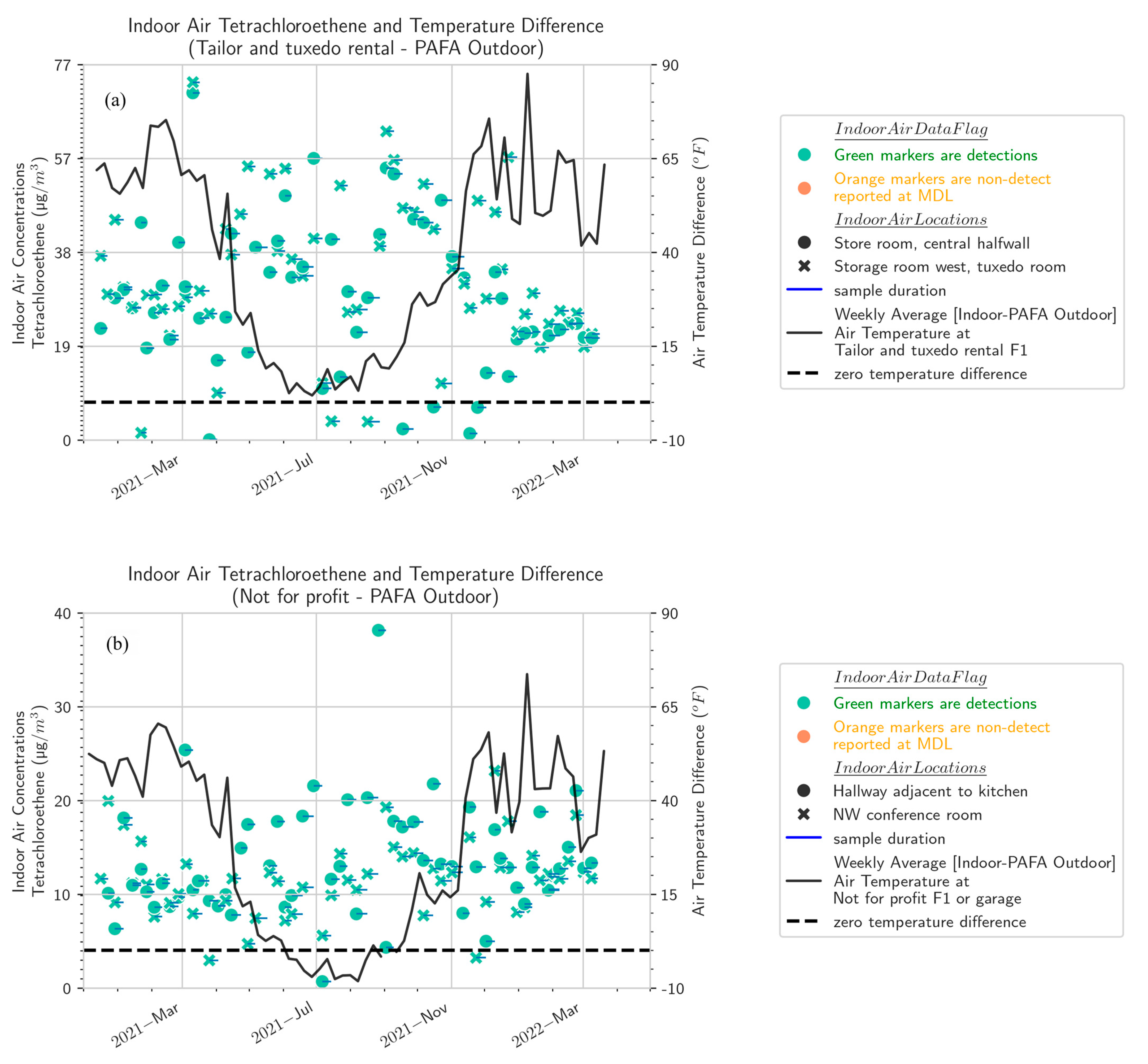
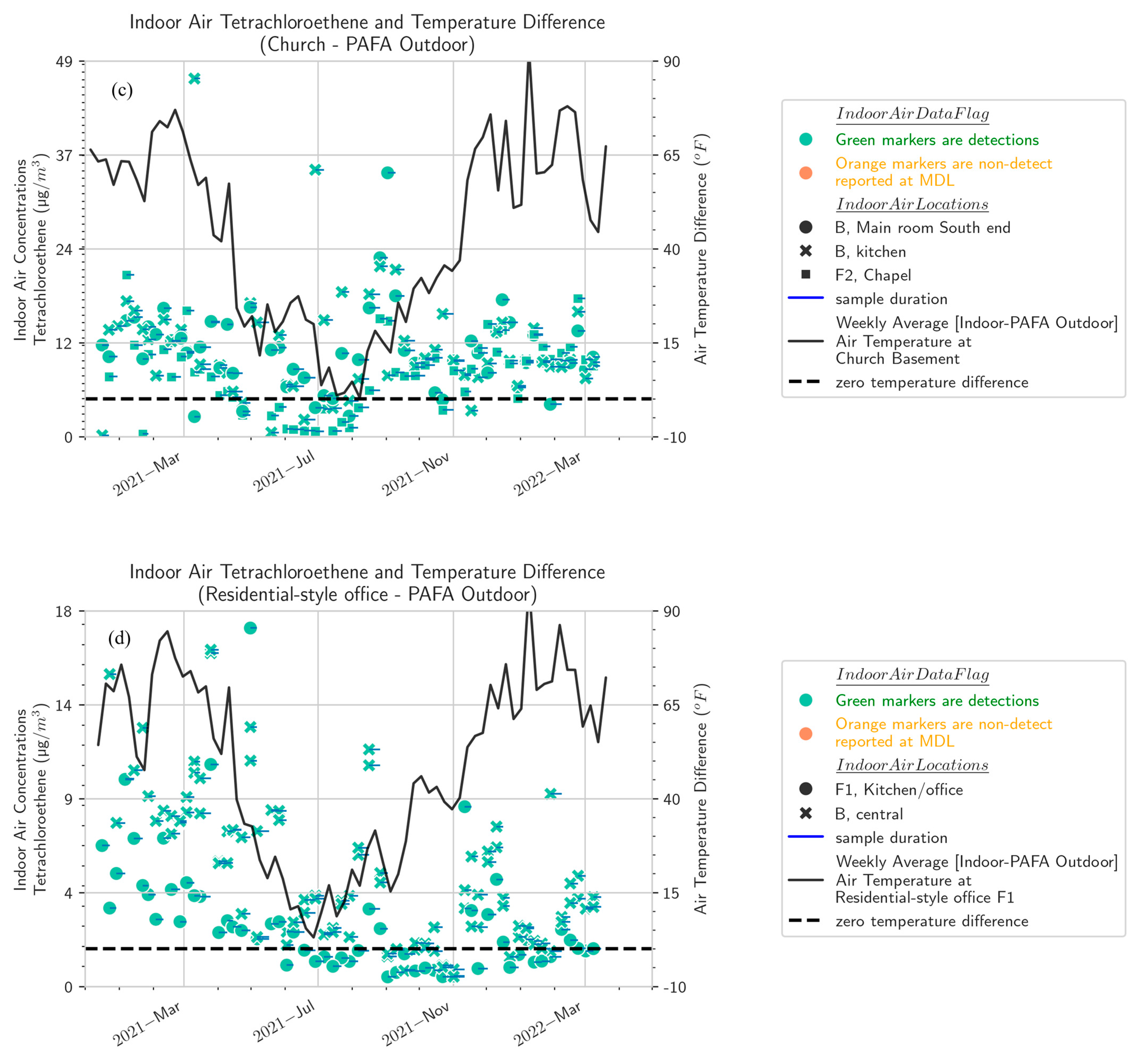
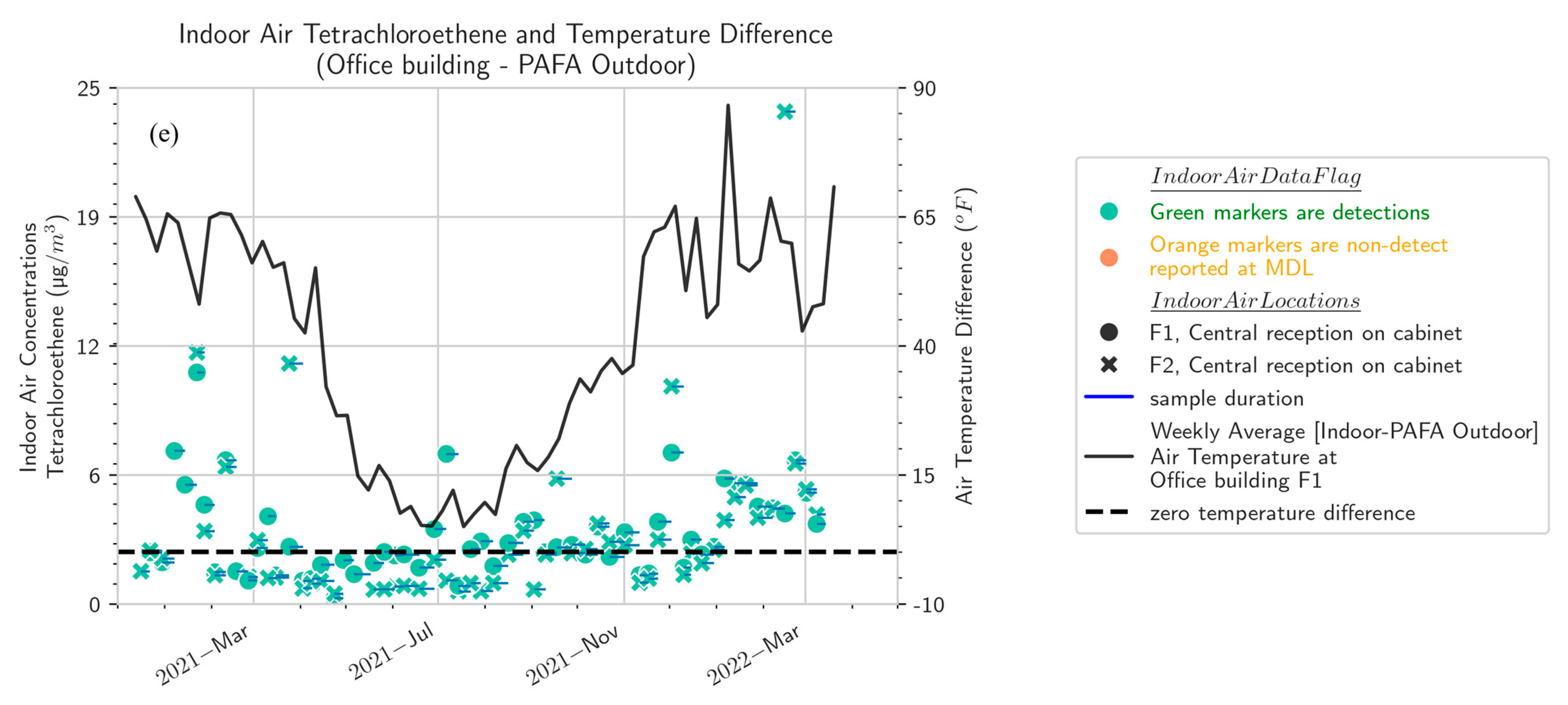
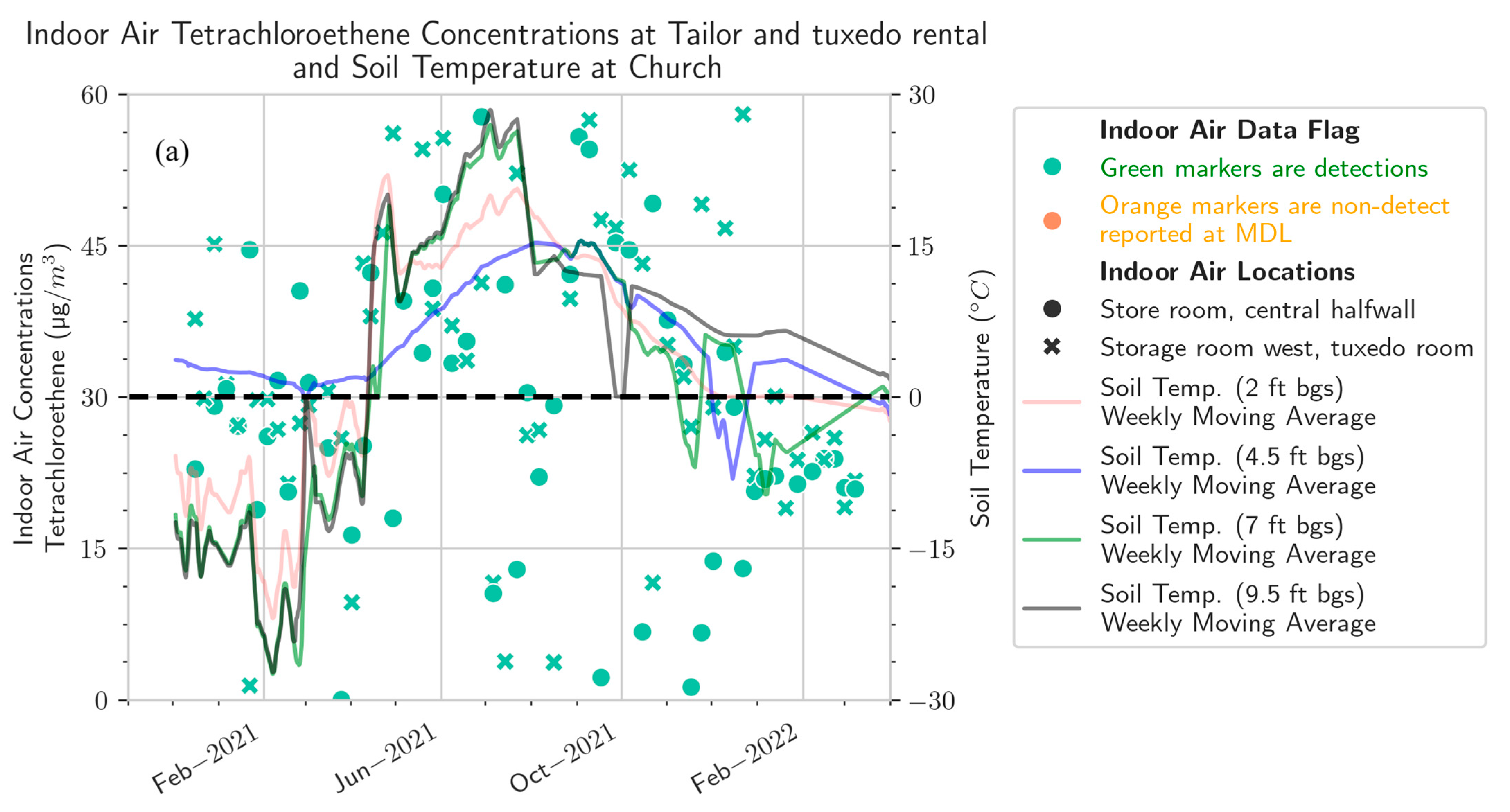
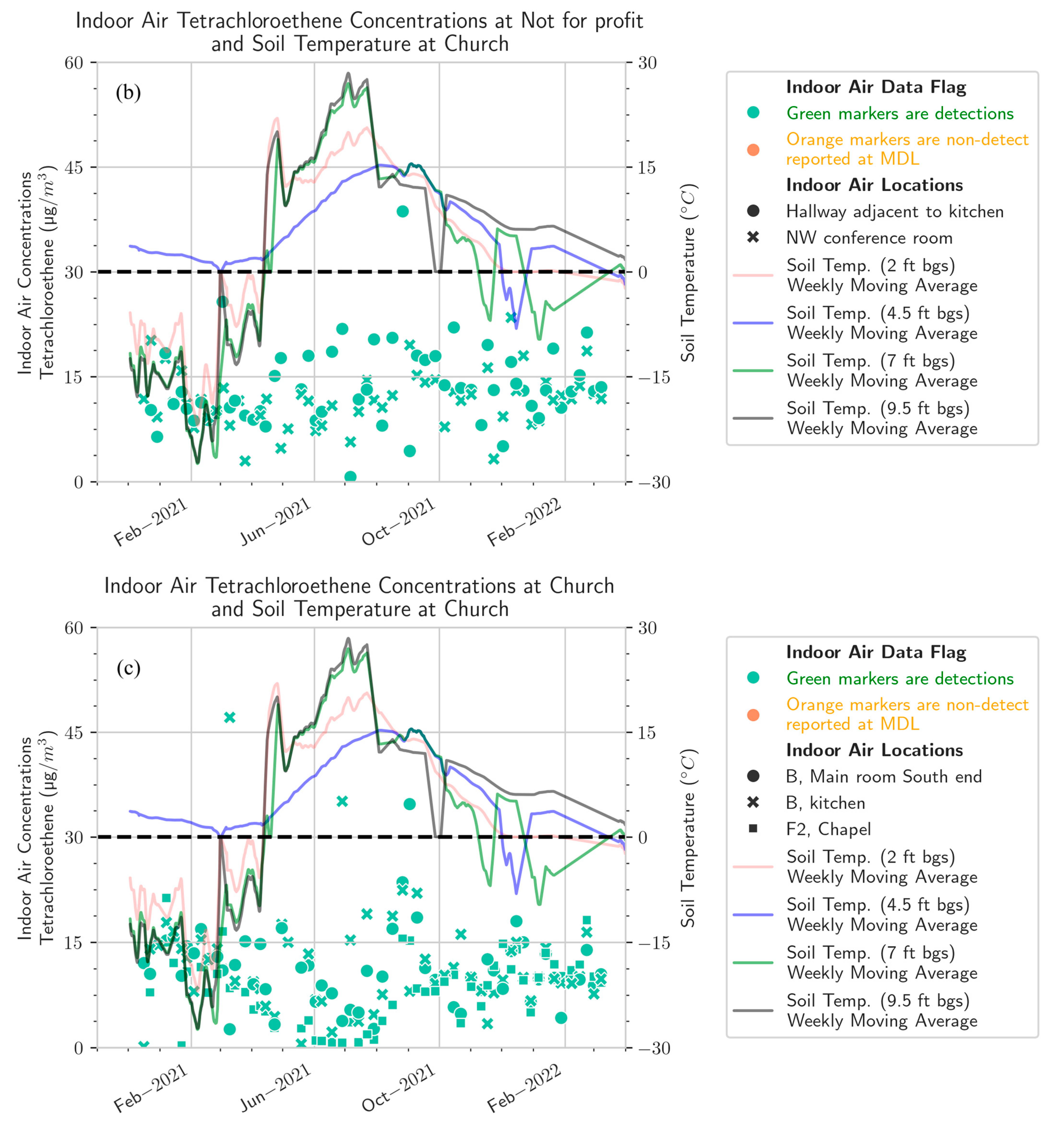
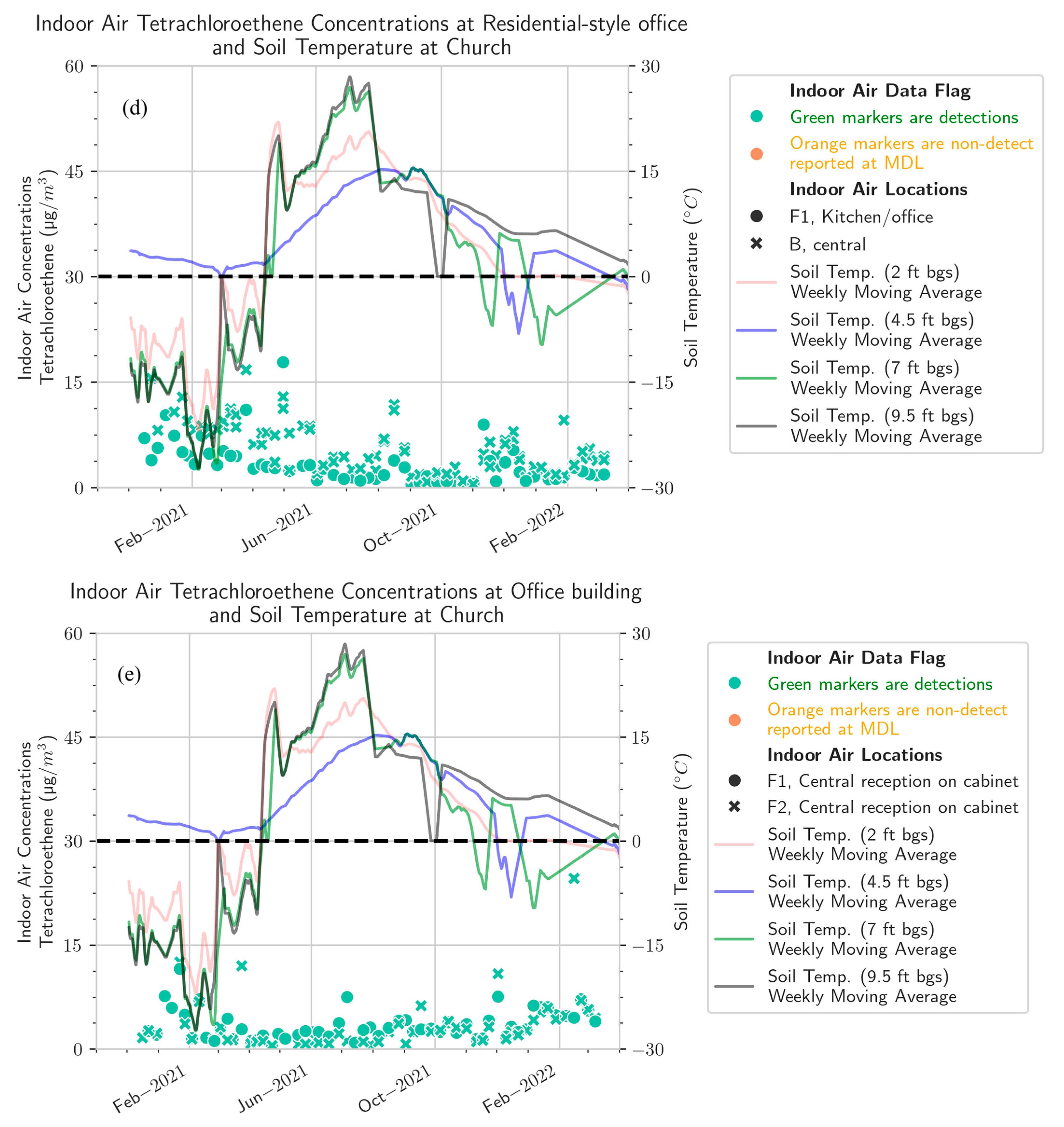
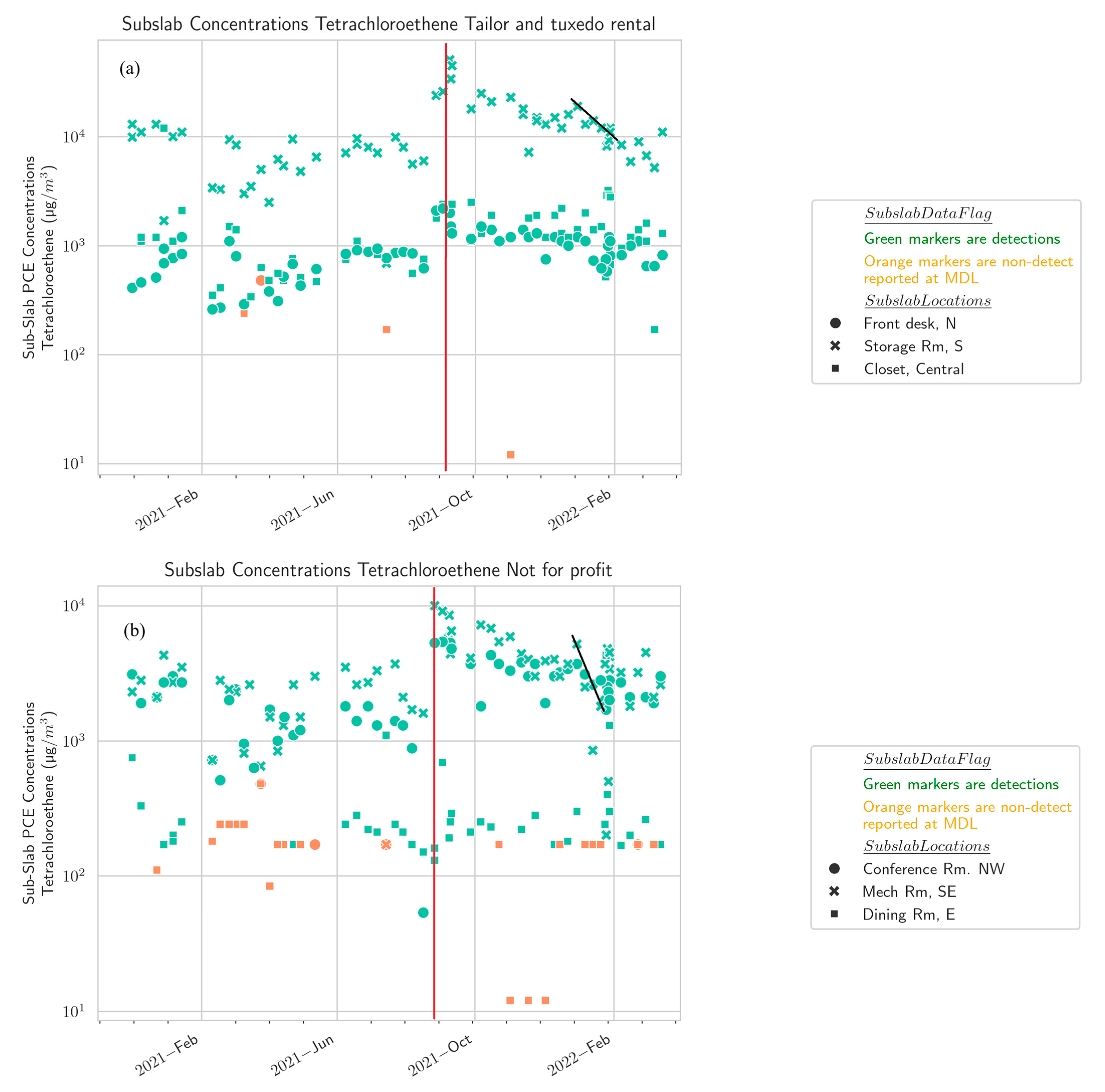
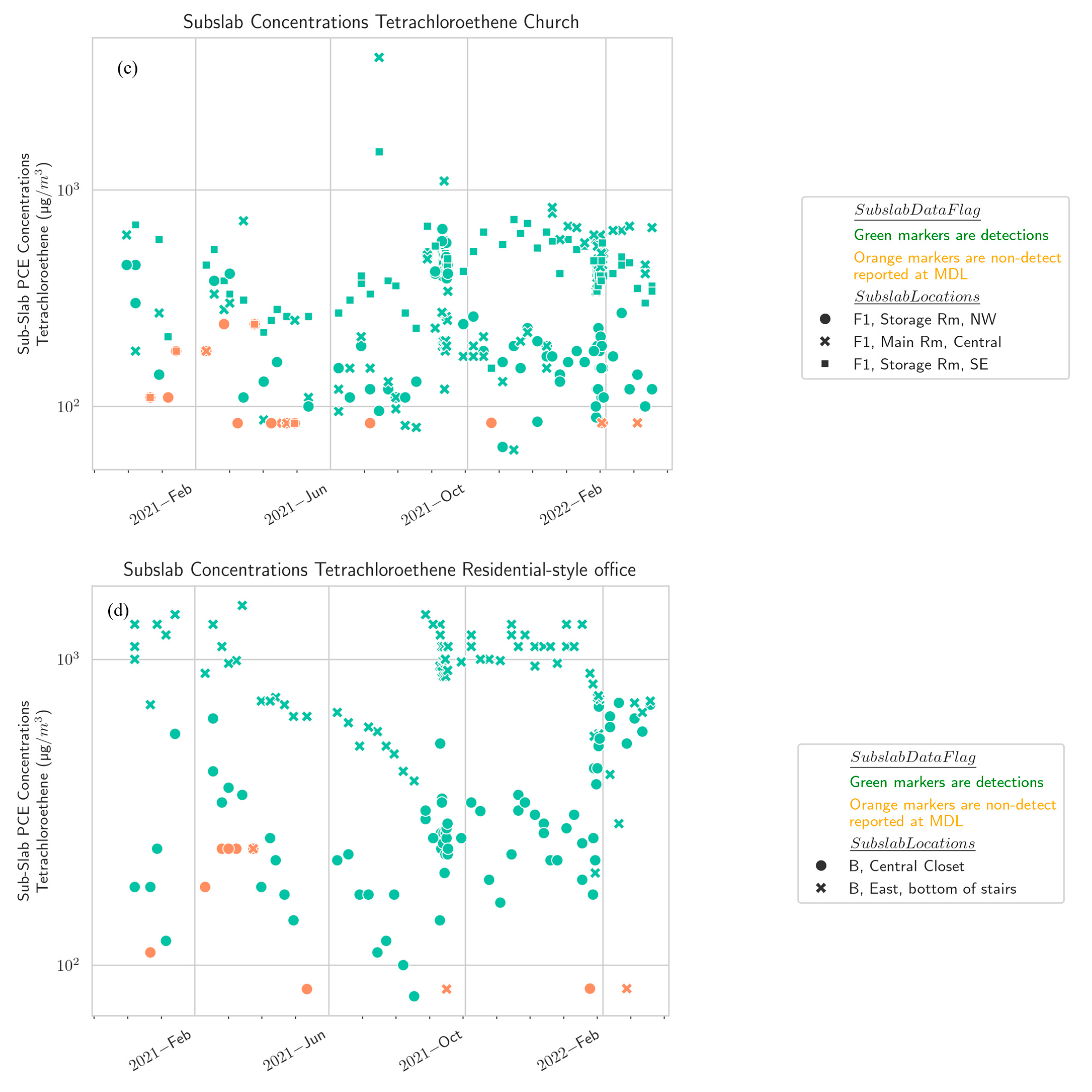
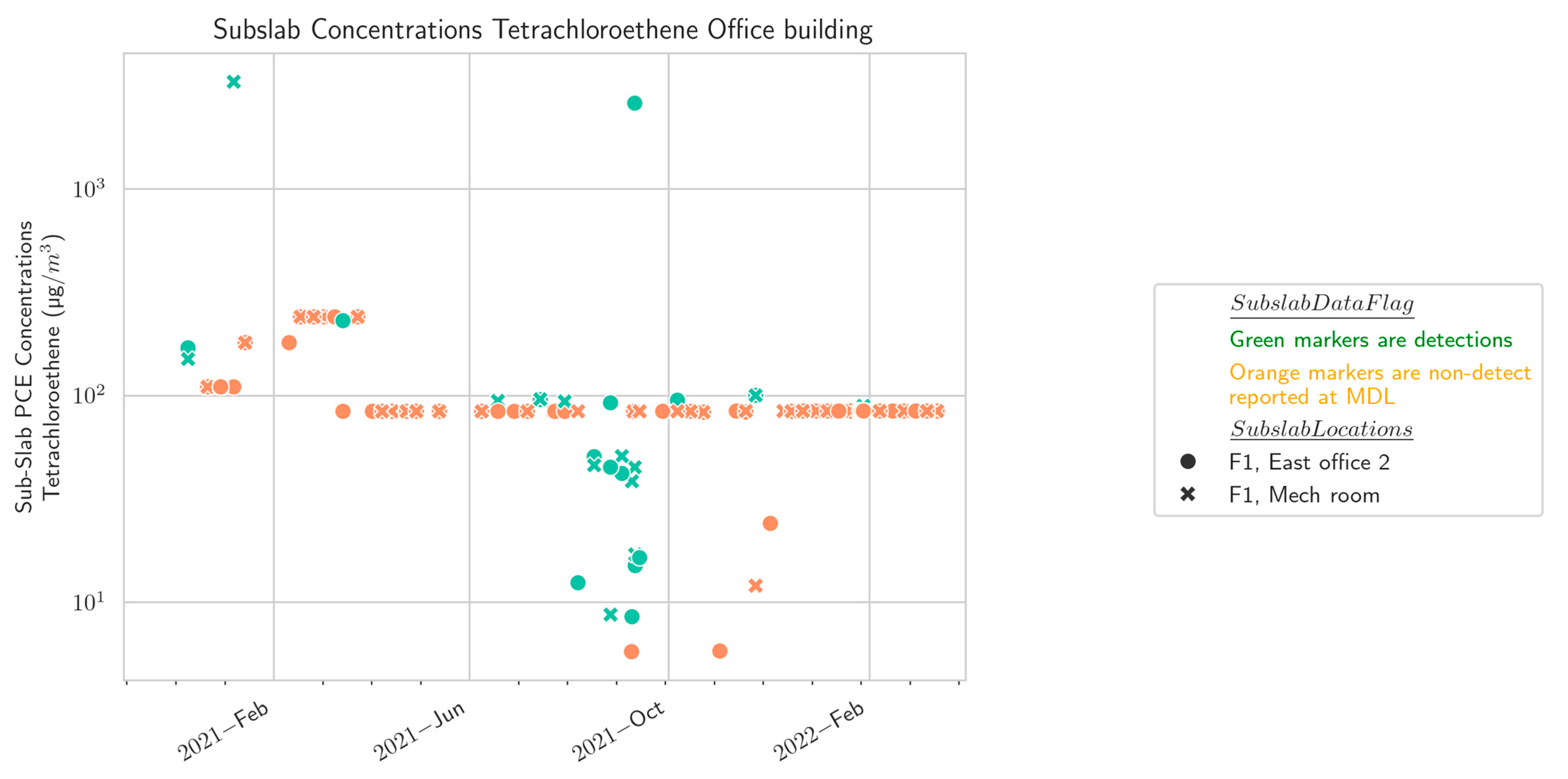


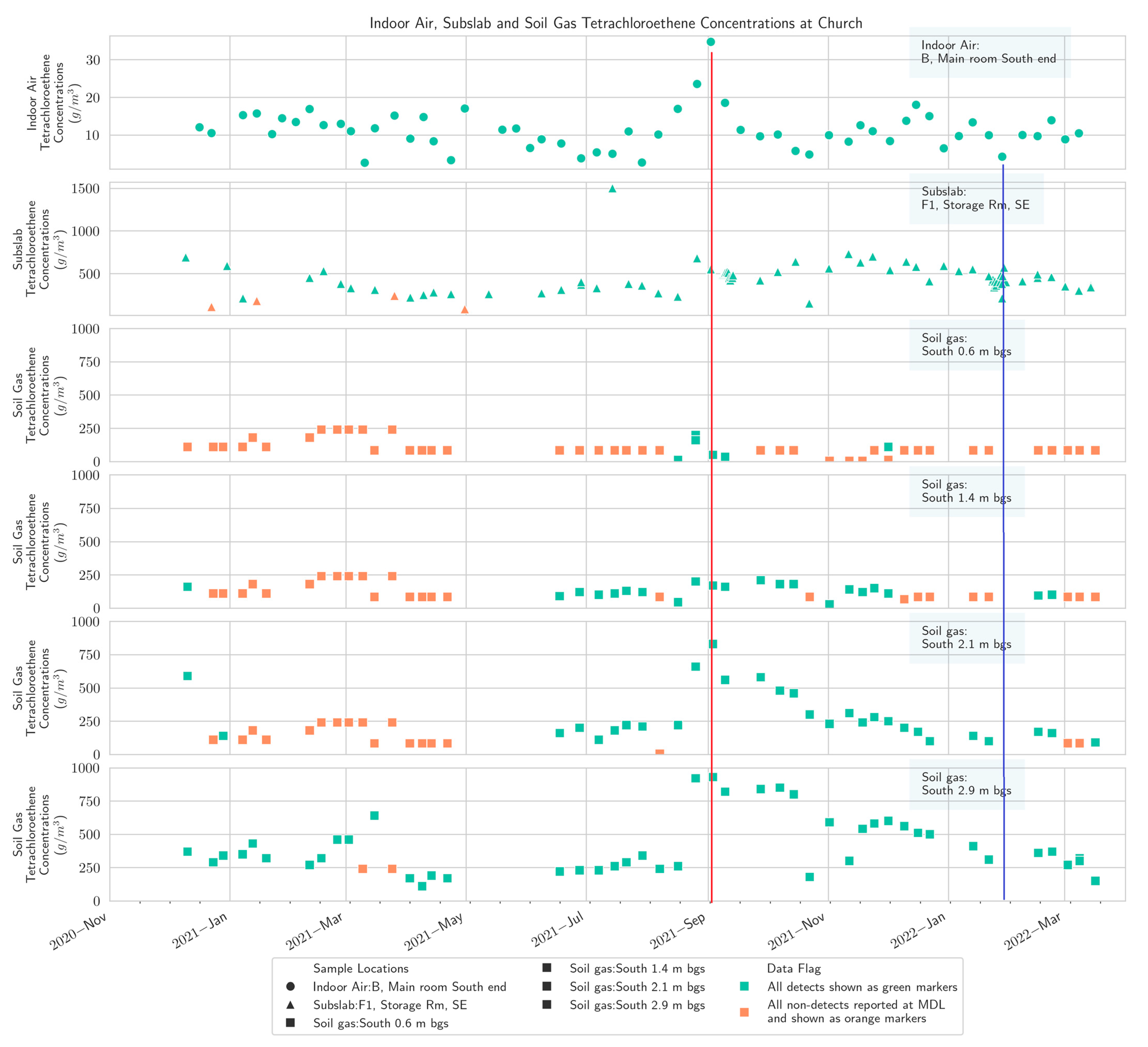
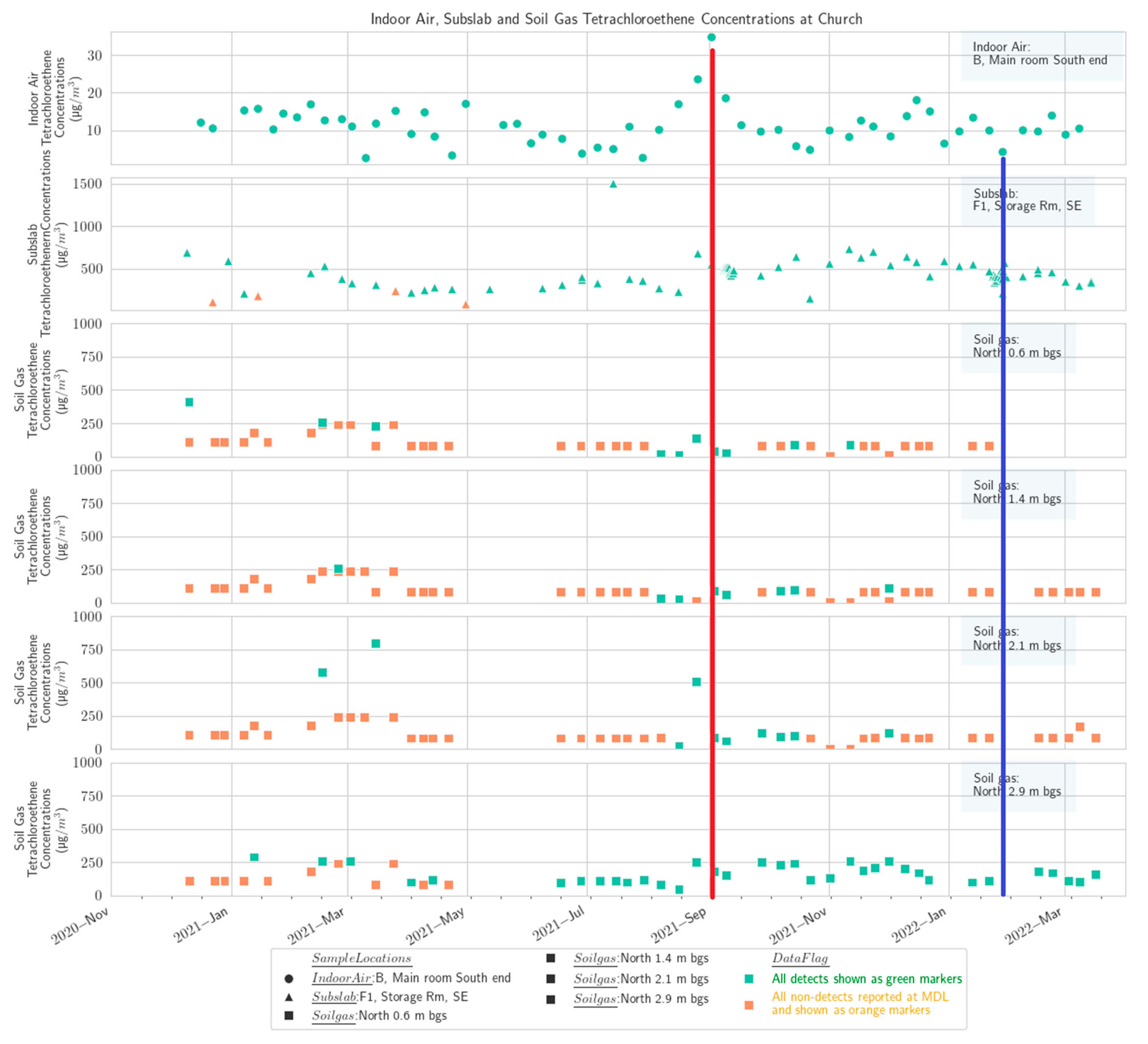
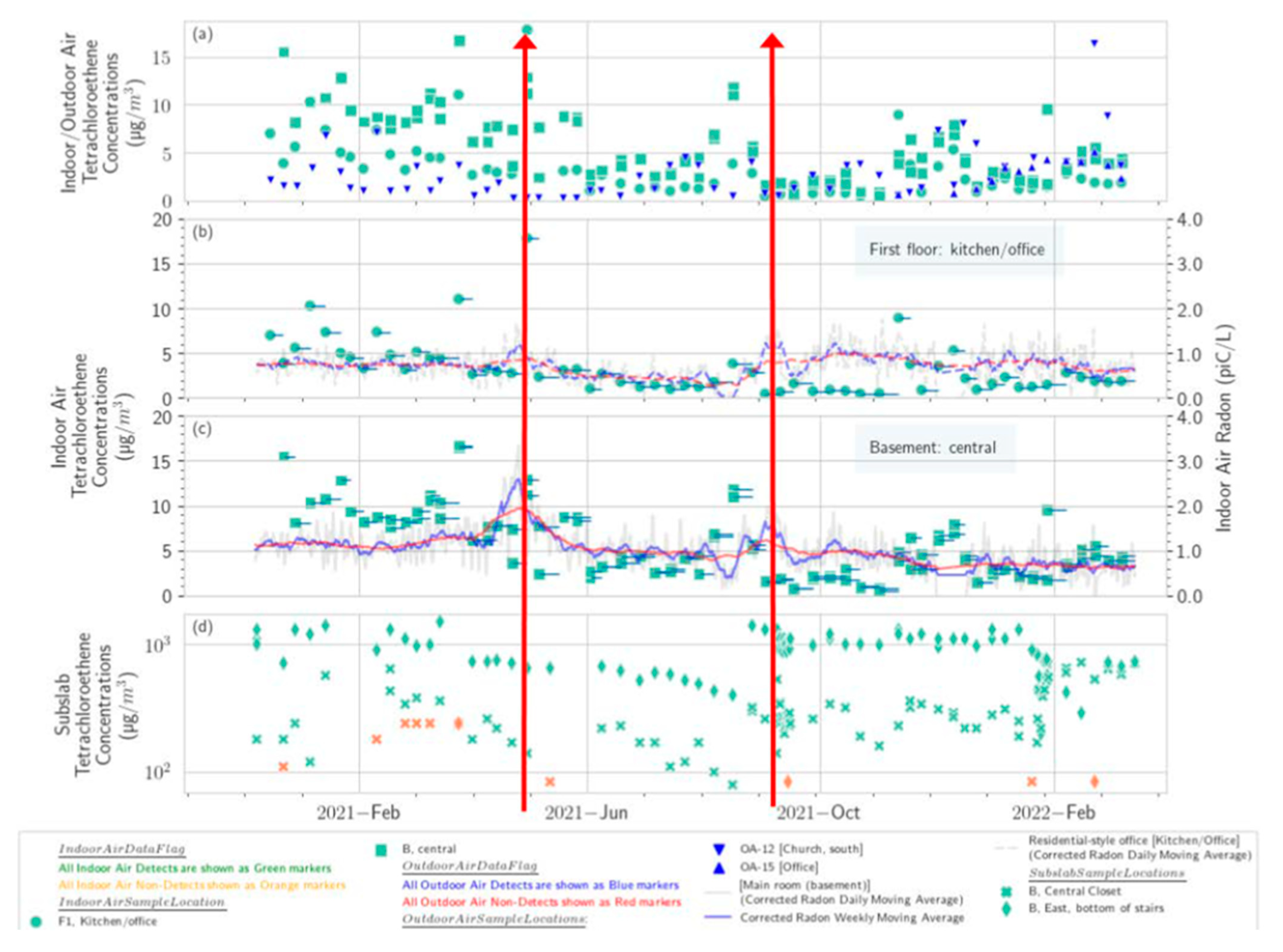

| Building | Building Characteristics | HVAC Characteristics | ||||||||||
|---|---|---|---|---|---|---|---|---|---|---|---|---|
| Description | Approximate m2 (ft2) | Number of Stories | General Construction Material/Style | Date of Construction, Additions and Major Renovations | Basement or Crawl Present? | Heating System | Heat Generation | Heat Distribution | Cooling System | Vent Systems | Number of Zones | |
| Eastern Plume/Source Area | ||||||||||||
| Not for profit | Non-profit organization; Four-plex | 369 (3975) | 1 | cinder block (property tax site says 8-inch concrete block) | 1950 | N | hot air circulation | boiler system appears to heat water to heat air; fuel oil used for boilers | air circulation ducts | central air (inlet appears to be from outside) | kitchen hood fan; bathroom fans | 1 |
| Tailor and tuxedo rental business | Tailor and tuxedo rentals; Four-plex | 454 (4890) | 1 | cinder block | 1950 | N | hot water baseboard (electric) | boiler system; fuel oil for boiler | hot water to radiators at baseboards; space heater in storage rooms | central air (not used) | fans in storage rooms for in-room heating | 1 |
| Residential-style office | Residential-style building; business office | 149 (1600) | 2 and basement | wood frame over poured concrete | 1951 | Y, basement with separate access | hot water radiation. Baseboards | fuel oil for heating | hot water to radiators at baseboards likely | bathroom vents | 3 | |
| Government building | Large government building with basement | 6500 (70,000) | 2 and basement | primarily reinforced concrete | Constructed in 1933-34 with additions in 1939 and 1948. Renovations in 1994. | Y, basement partially below grade | hot water radiation | district steam plant | radiators in most offices; air handling room on 3rd floor includes heated coils (steam) | Central air in some areas; most offices have individual AC units | central ventilation with large vents in most portions of the building | |
| Western Plume/Source Area | ||||||||||||
| Office Building | first floor office | 156 (1680) | 2 | concrete slab; brick and wood frame | 1970 | N | hot water radiation | fuel oil | hot water to radiators at baseboards likely | 1st floor: central air, outside intake; 2nd floor: individual AC units, | 1st floor: fans, bathroom fans; 2nd floor: fans, bathroom fans | 3 |
| second floor office | ||||||||||||
| Church | Place of worship | 557 (6000) | split level first floor over basement | cinder block walls in basement; wood frame above | 1952 | Y, basement partially below grade | plate exchanger with hot water radiation (baseboards) | hot water from city central hot water; fuel oil | hot water to radiators at baseboards likely | bathroom vents, outside air intake with exhaust at south end of chapel | Possibly 6 | |
| Building | Indoor Air Location/Sample ID | Long Term Average Indoor Air PCE 1 | Standard Deviation Indoor Air PCE | Subslab Location/Sample ID | Long Term Average Subslab PCE | Standard Deviation Subslab PCE | SS AF, Corrected for Ambient (Unitless) | SS AF Standard Deviation |
|---|---|---|---|---|---|---|---|---|
| Church | Basement (Main Room, South end); IA-50 | 11.23 (n = 57) | 5.33 | Basement (Main Room, Central; Storage Room, SE) SS-54, SS-56 | 427.28 (n = 152) | 363.33 | 0.0202 | 0.0196 |
| Church | Basement (Kitchen); IA-51 | 12.03 (n = 59) | 7.43 | Basement (Storage Room, NW); SS-55 | 247.49 (n = 82) | 154.47 | 0.0381 | 0.0334 |
| Residential-style Office | Basement; IA-43 | 5.49 (n = 108) | 3.63 | Basement (Central Closet; East, bottom of stairs) SS-59, SS-60 | 621.31 (n = 159) | 383.32 | 0.0046 | 0.0042 |
| Tailor and Tuxedo | Tuxedo room; IA-44 | 33.74 (n = 58) | 15.22 | Front desk, N; SS-48 | 942.17 (n = 63) | 413.61 | 0.0330 | 0.0208 |
| Tailor and Tuxedo | Central half-wall; IA-45 | 29.05 (n = 56) | 14.85 | Storage Room, S; SS-49 | 11957.66 (n = 64) | 9127.20 | 0.0022 | 0.0020 |
| Not For Profit | Hallway near kitchen; IA-47 | 13.57 (n = 58) | 5.93 | Mech Room, SE; SS-53 | 3407.58 (n = 62) | 2064.16 | 0.0032 | 0.0024 |
| Not For Profit | Conference room; IA-46 | 12.16 (n = 58) | 5.28 | Conference Room NW; SS-51 | 2490.24 (n = 57) | 1299.33 | 0.0038 | 0.0026 |
| Office building | First floor; IA-48 | 3.5 (n = 58) | 2.18 | East office 2; SS-57 | 255.14 (n = 14) | 677.90 | 0.0035 | 0.0095 |
| Outdoor Air | 2.61 (n = 86) | 2.75 | NA | NA | NA | NA | NA |
Disclaimer/Publisher’s Note: The statements, opinions and data contained in all publications are solely those of the individual author(s) and contributor(s) and not of MDPI and/or the editor(s). MDPI and/or the editor(s) disclaim responsibility for any injury to people or property resulting from any ideas, methods, instructions or products referred to in the content. |
© 2025 by the authors. Licensee MDPI, Basel, Switzerland. This article is an open access article distributed under the terms and conditions of the Creative Commons Attribution (CC BY) license (https://creativecommons.org/licenses/by/4.0/).
Share and Cite
Zimmerman, J.H.; Williams, A.; Schumacher, B.; Lutes, C.; Warrier, R.; Cosky, B.; Thompson, B.; Holton, C.W.; Bronstein, K. Impact of Multiple HVAC Systems on Indoor Air VOC and Radon Concentrations from Vapor Intrusion During Seasonal Usage. Atmosphere 2025, 16, 378. https://doi.org/10.3390/atmos16040378
Zimmerman JH, Williams A, Schumacher B, Lutes C, Warrier R, Cosky B, Thompson B, Holton CW, Bronstein K. Impact of Multiple HVAC Systems on Indoor Air VOC and Radon Concentrations from Vapor Intrusion During Seasonal Usage. Atmosphere. 2025; 16(4):378. https://doi.org/10.3390/atmos16040378
Chicago/Turabian StyleZimmerman, John H., Alan Williams, Brian Schumacher, Christopher Lutes, Rohit Warrier, Brian Cosky, Ben Thompson, Chase W. Holton, and Kate Bronstein. 2025. "Impact of Multiple HVAC Systems on Indoor Air VOC and Radon Concentrations from Vapor Intrusion During Seasonal Usage" Atmosphere 16, no. 4: 378. https://doi.org/10.3390/atmos16040378
APA StyleZimmerman, J. H., Williams, A., Schumacher, B., Lutes, C., Warrier, R., Cosky, B., Thompson, B., Holton, C. W., & Bronstein, K. (2025). Impact of Multiple HVAC Systems on Indoor Air VOC and Radon Concentrations from Vapor Intrusion During Seasonal Usage. Atmosphere, 16(4), 378. https://doi.org/10.3390/atmos16040378






